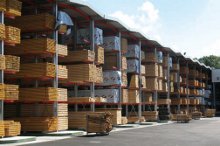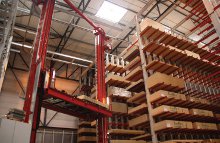In-store efficiency
10 August 2013An automated storage facility has improved productivity for a French buying group.
June 7 was quite an occasion for CAB56 (Cooperative des Artisans du Bois). Not only did the French buying co-operative celebrate its 15th anniversary, it also held the official opening of its new automated storage facility, with more than 1,000 co-operative members and guests from industry and local government attending the event.
CAB56 is one of France's leading purchasing groups for timber and building materials and among its 350 members are local carpenters, joiners, roofing contractors, interior decorators and small building contractors.
Its new 4,500m² warehouse, in Plescop, Brittany was quite an undertaking but managing director Philippe Mérian is pleased with the result. "We initially underestimated the scope of the process but we've made an enormous transition and made the right decision, especially considering the economic climate," he said.
The new facility was designed to expand the storage capacity of long goods, wood-based panels, laminate panels and palletised material. In addition to new high-bay cantilever racking supplied by Ohra, Hamon motor-driven conveyor systems connecting service areas, and three Koettgen automated aisle-changer stacker cranes, the project also included an Innolog order fulfilment software system (WMS) interfaced with the in-house ERP system to integrate all storage, picking and distribution tasks on the entire 20,000m² site.
The project design team, comprising CAB56, Axisbois consultants, and Ohra as the general contractor for racking, software and stacker cranes, divided the new distribution concept into three zones and implementation stages: zone 1 - automated storage and retrieval of chipboard, MDF and laminates; zone 2 - automated storage and retrieval of diverse building materials such as aluminium profiles, windows, door blanks or parquet flooring; zone 3 - integration of all other storage areas on the site, including outdoor storage into the WMS system via bar code and radio frequency control terminals on all handling equipment.
Construction of the 20m-high building started in June 2011. The main structure, including the slab, cladding and roofing, was completed by the end of 2012. The erection of just over 900 tons of racking construction began in January 2012 and took four months to complete. In February 2012 the first crane was installed and started working two months later. By the end of August 2012 the final two stacker cranes were installed and in operation. Integration of outdoor storage areas was completed in March this year.
In zone 1 a fully-automated stacker crane operates in three aisles and handles chipboard packages of up to 5.1m long and weighing five tons, or pallets of laminates either for customer orders or manufacturing orders from the inhouse cutting and edging facility. Integrated chain belt and roller conveyor systems collect the goods from the crane and transport the material to the appropriate workstation.
In zone 2, two stacker cranes have a loadbearing capacity of 4 tons and handling capacity to lift goods of up to 4.2m in length to 12.5m high. They operate either in a fullyautomatic mode for after-hours stock refill or semi-automatically in a "man to goods" mode, combining manual picking for multiple orders or multi-line orders with the advantage of automatically guided transfer.
The two cranes have access to eight aisles and, as with the automatic crane in zone 1, can change from aisle to aisle. With a top speed of 150m/min the cranes can handle more than 50 full loads per hour.
Cantilever racking in all areas provides the most flexible storage variations for CAB56's diverse stock. The racking, which is 14.5m high and 75m long, with a load-bearing capacity of 19,200kg per column, also provides the superstructure for the upper guide rails of the stacker cranes
The final stage of the project - zone 3 - entailed the integration of all new and existing storage areas on the entire site, including outdoor floor areas and order preparation docks, into the WMS system and equipping fork trucks with mobile radio-controlled order fulfilment terminals, transferring paperless order information to operators and providing enhanced real-time performance information for managers.
Philippe Mérian said that, in terms of size and complexity, the facility is the first of its kind in France's merchant sector.
"Numerous associated co-operatives and timber merchants have visited our site to see what we've done together with Ohra," he said.
"We've increased our storage capacity by almost 50%, so avoiding having to create a second site. At the beginning we were treading on new ground but we had faith in the expertise of our long-term partners who had already implemented several installations of this kind in other countries."
CAB56's aim was to have complete control of all distribution processes, reduce errors and damage to goods, minimise manual handling to preserve product quality and reduce sick leave. And it's achieved its goal.
"In the first months after the first phase, productivity in our furniture workshop, which produces wooden components, doubled," said Mr Mérian. "Damaged stock is now near zero, sick rates are much lower due to a reduction in manual handling of heavy product and we have no more picking mistakes. We have permanent stock control, and inventory differences are negligible."

